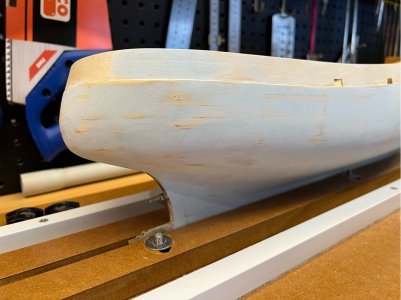Hi,
I'm building Billing's Mary Ann, as an RC model, and it has been suggested that I should epoxy/fibreglass the hull to prevent future splitting of the planked hull (I had a recent post showing this problem). I’m seriously considering this (fabric is on order) but I have a question about how to lay the fabric.
My concern is at the stern. This hull has a lovely rounded stern (see photos below)…there is no transom with a hard edge to finish the fabric edge against. I plan to use a very fine fabric weight (30g/m or 0.88oz/yd).
I can see three potential options…
1) Do each side separately, with a join (or overlap??) at the centre of the stern
2) Try and do a wrap from bow to stern, around and back up the other side, ie wrap a single strip…I can’t see that going well though
3) Do it in three pieces…stern up to the prop shaft exit, then each side with a join/overlap.
I suspect that option 1, the conventional approach, is the most practical. I’m assuming that this weight of fabric is so thin that it will not be too difficult to either mould the shape without creases, and the resulting fabric overlap won’t be too hard to hide with appropriate filling and sanding after the epoxy coats.
I have very limited experience with epoxy other than simple gluing and coating the interior, have never used fabric. I’ve watched many YouTubes and other posts, but I’m not finding other examples with a rounded stern. I’ll probably make up a foam shape to run a practice on, but I’d appreciate thoughts from others who have coated a similar shaped hull.


Thanks
I'm building Billing's Mary Ann, as an RC model, and it has been suggested that I should epoxy/fibreglass the hull to prevent future splitting of the planked hull (I had a recent post showing this problem). I’m seriously considering this (fabric is on order) but I have a question about how to lay the fabric.
My concern is at the stern. This hull has a lovely rounded stern (see photos below)…there is no transom with a hard edge to finish the fabric edge against. I plan to use a very fine fabric weight (30g/m or 0.88oz/yd).
I can see three potential options…
1) Do each side separately, with a join (or overlap??) at the centre of the stern
2) Try and do a wrap from bow to stern, around and back up the other side, ie wrap a single strip…I can’t see that going well though
3) Do it in three pieces…stern up to the prop shaft exit, then each side with a join/overlap.
I suspect that option 1, the conventional approach, is the most practical. I’m assuming that this weight of fabric is so thin that it will not be too difficult to either mould the shape without creases, and the resulting fabric overlap won’t be too hard to hide with appropriate filling and sanding after the epoxy coats.
I have very limited experience with epoxy other than simple gluing and coating the interior, have never used fabric. I’ve watched many YouTubes and other posts, but I’m not finding other examples with a rounded stern. I’ll probably make up a foam shape to run a practice on, but I’d appreciate thoughts from others who have coated a similar shaped hull.


Thanks










